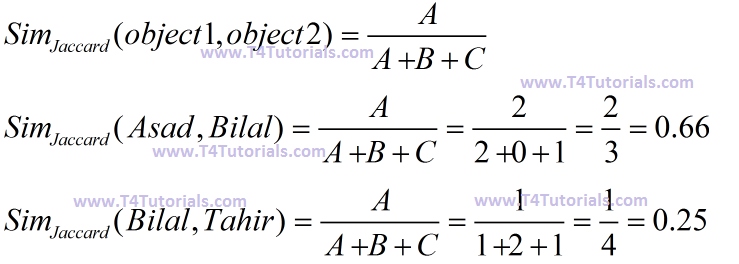How to calculate the similarity of an asymmetric binary variable using Jaccard coefficient?
There are many methods to calculate the similarity of data. Jaccard coefficient is one of them.Jaccard coefficient is used to calculate the similarity among asymmetric binary attributes.
Contingency table for binary data:
| Object 2 | ||||
| Object 1 | 1 / True / Positive | 0 / False / Negative | Sum | |
In table 1 we can consider the following facts.
A represents that object 1 is True and object 2 is also True.
B represents that object 1 is True and object 2 is False.
C represents that object 1 is False and object 2 is True.
D represents that object 1 is False and object 2 is also False.
| Name | Fever | Cough | Test 1 | Test 2 | Test 3 | Test 4 |
| Asad | Negative | Yes | Negative | Positive | Negative | Negative |
| Bilal | Negative | Yes | Negative | Positive | Positive | Negative |
| Tahir | Positive | Yes | Negative | Negative | Negative | Negative |
In table 2, Asad, Bilal and Tahir are objects. Negative values represent False and Positive represents Negative.
Consider 1 for positive/True and 0 for negative/False.

Similarly, we can calculate the similarity of one object with each other object.
Video Lecture
Next Similar Tutorials
- Proximity Measure for Nominal Attributes – Click Here
- Distance measure for asymmetric binary attributes – Click Here
- Distance measure for symmetric binary variables – Click Here
- Euclidean distance in data mining – Click Here Euclidean distance Excel file – Click Here
- Jaccard coefficient similarity measure for asymmetric binary variables – Click Here
- Cosine similarity in data mining – Click Here, Calculator Click Here
- Correlation analysis of numerical data – Click Here
